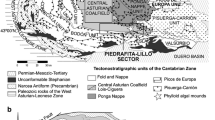Abstract
Combined field studies, thin-section examination and scanning electron microscopy were utilized to study the diagenesis of the Quaternary carbonates in twelve stratigraphic sections along the coastline of Qatar. The sequence is dominated by calcarenites. It comprises three lithostratigraphic units representing two transgressive phases of the Pleistocene sea separated by a regressive phase.
Diagenesis has modified the original textural and compositional characteristics of the Quaternary rocks considerably. Dissolution and cementation played major roles, whereas neomorphism and compaction were much less effective. Dissolution resulted in the development of fabric-and nonfabric-selective types of porosity. Cementation was mainly by calcite and, rarely, aragonite, gypsum and silica. Calcite crystals are nonferroan, mainly low-magnesian and have wide ranges of size, habit and distribution patterns. Aragonite cements are commonly crystals are nonferroan, mainly low-magnesian and have wide ranges of size, habit and distribution patterns. Aragonite cements are commonly isopachous and consist of fibrous and needle-like crystals. Massive and fibrous gypsum and cryptocrystalline and microcrystalline silica fill intergranular pores and microchannels. Aggrading and degrading neomorphism were selective. Compaction effects were more profound in calcarenites which were not subjected to early cementation.
The diagenesis of the Quaternary carbonates occurred in a wide spectrum of settings which prevailed during the eogenetic, mesogenetic and telogenetic phases. The marine phreatic environment witnessed the commence of cementation with aragonite and high-magnesian calcite and the formation of micritic envelopes of fossil shells. The early phases of dissolution, micritization of other allochems and aggrading neomorphism occurred under mixed phreatic conditions. Most of the recorded diagenetic effects were developed in the meteoric vadose and phreatic environments. These include the completion of the dissolution events, the cementation with sparitic low-magnesian calcite, silica and gypsum, and the conversion of aragonite into low-magnesian calcite. There are remarkable variations in the nature and intensity of freshwater cementation throughout the sequence which indicate marked fluctuations in the groundwater levels.
Similar content being viewed by others
References
AU-ZEID, M.M., ABD EL HAMEED, A.T., and AL KUWARI, A.J., 1999, Petrology, Mineralogy and Sedimentation of the Coastal Quaternary Carbonates in Qatar, Arabian Gulf:Carbonates and Evaporites, v. 14, no. 2, p. 209–224.
BATHURST, R.G.C., 1975, Carbonate Sediments and Their Freshwater Diagenesis of Saurashtra Miliolites:Journal of Geological Society of India, v. 48, p. 415–419.
BHATT, N. and PATEL, M.P., 1998, Diagenesis in the Quaternary Carbonate Sediments of Saurashtra and Kachchh, Western India,in Alsharhan, A.S., Glennie, K.W., Whittle, G.L., and Kendall, C.G.St.C., eds., Quaternary Deserts and Climatic Change. Balkema, Rotterdam, 621 p.
CAVELIER, C., 1970, Geological Description of the Qatar Peninsula. Department of Petroleum Affairs, Qatar, 39 p.
CAVELIER, C., SALATT, A., and HEUZE, Y., 1970, Qatar Geologicla Maps 1∶1,000,000. Department of Petroleum Affairs, Qatar.
DICKSON, J.A.D., 1965, A Modified Staining Technique for Carbonates in Thin Section:Nature, v. 205, 587 p.
FRIEDMAN, G.M., 1959, Identification of carbonate minerals by staining methods:Journal of Sedimentary Petrology, v. 29, p. 87–97.
FRIEDMAN, G.M., GEBELEIN, C.D., and SANDERS, J.E., 1971, Micrite Envelopes of Carbonate Grains Are Not Exclusively of Photosynthetic Algal Origin:Sedimentology, v. 16, p. 89–96.
HEEGER, J.E. 1913, Ueber die mikrochemische Untersuchung fein verteilter Carbonate im Gesteinsschliff: Centralblatt Mineralogie, Geologie, und Palaontologie, p. 44–51.
HESSE, R., 1989, Silica Diagenesis: Origin of Inorganic and Replacement Cherts:Earth Sciences Review, v. 26, p. 253–284.
JAMES, N.B. and CHOQUETTE, P.E., 1984, Diagenesis in Limestones. The Meteoric Diagenetic Environment:Geoscience Canada, v. 11, p. 161–194.
LASCHET, C., 1984, On the Origin of Chert:Facies, v. 10, p. 257–290.
MOORE, C.H., 1989, Carbonate Diagenesis and Porosity. Developments in Sedimentology, Elseveir, v. 46, 338 p.
MORSE, J.W. and MACKENZIE, F.T., 1990, Geochemistry of Sedimentary Carbonates. Developments in Sedimentology, Elsevier, v. 48.
MÜLLER, G., 1971, Gravitational Cement: An Indicator for the Vadose Zone of the Subarial Diagenetic Environment.in Bricker, O.P., ed., Carbonate Cements. p. 301–302, Baltimore, John Hopkins Universituy Press.
PERTHUISOT, J.P., 1977, Contribution a l’ étude du Quaternaire Marin de la Péninsule de Qatar:Bulliten Societie Géologie France, v. 7, no. 6, p. 1167–1170.
SCHOLLE, P.A., STEMMERIK, L., and ULMER, D.S., 1991, Diagenetic History and Hydrocarbon Potential of Upper Permian Carbonate Buildups, Wegener Halvo Area, Jamson Land Basin, East Greenland:American Association for Petroleum Geologists Bulletin, v. 75, p. 701–725.
Author information
Authors and Affiliations
Rights and permissions
About this article
Cite this article
Abu-Zeid, M.M., Abd El Hameed, A.E.N.T. & Al Kuwari, A.J. Diagenesis in the coastal quaternary carbonates in Qatar, Arabian Gulf. Carbonates Evaporites 16, 26–36 (2001). https://doi.org/10.1007/BF03176224
Received:
Accepted:
Published:
Issue Date:
DOI: https://doi.org/10.1007/BF03176224




